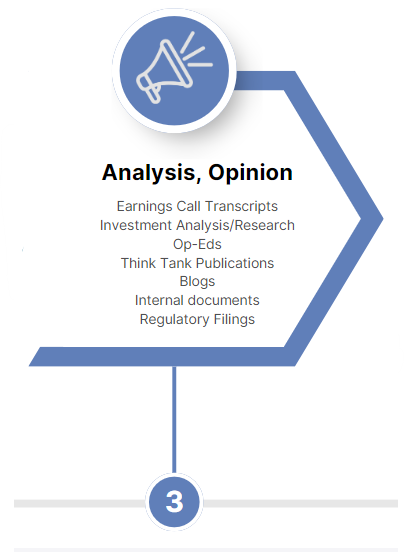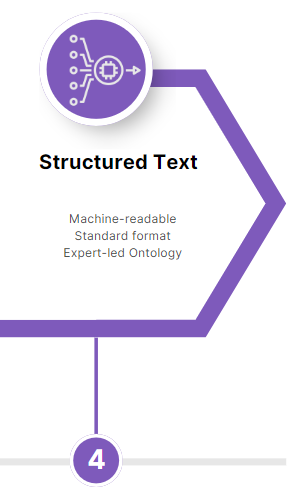AI Training Data for Global Macro Economics: Text and Language
- BCMstrategy, Inc.

- Jul 15
- 5 min read
Public policy risks present first in verbal format. You know this. Markets know this -- they react instantly to headlines. The accelerating Generative AI revolution within knowledge industries holds the promise of making it easier to spot significant shifts in public policy before the headlines hit. It's a fast track to alpha-generating decision intelligence, if you can configure your machines properly....and if you can feed those machines the right data.

The great hunt for AI training data for global macro economics, text and language edition, has begun! Wall Street is exploring this field with great interest. Geopolitical rebalancing and policy volatility from tariffs and critical minerals to energy and climate policy to monetary policy provide daily reminders that market-moving language is everywhere.
If you are on the hunt to train your Generative AI and predictive analytics AI processes on public policy issues, this post is for you.
Many succumb to the "kitchen sink" or "spaghetti bowl" school of language training. They dump a bunch of unstructured text into a generative AI model and hope for the best. It is 21st century alchemy which costs firms precious capital (lost time, inaccurate outputs) in addition to lost cash using language that moves markets and changes people's lives.
This is not a recipe for success in the capital markets for a range of reasons. The top three reasons are:
Public policy language has many unique properties (which is a topic for another day).
Many people have very uninformed opinions about public policy, which means generative AI models training in this vertical are at a very high risk of Grensham's Law (the sheer volume of sub-standard content outweighs the meaningful content).
Most tech teams have no idea where to start collecting training data for use cases at the intersection of public policy and capital markets. Just because public policy text is open source does not mean that it is easy to find or access. Spoiler alert -- a kitchen sink approach to language data acquisition is a fast track to high costs, slow training times, and suboptimal outputs.
This post seeks to help global macro strategists structure more effective text acquisition strategies to support their portfolio priorities. You don't need 21st century alchemy to succeed and you don't need to wait for the AI to reach the same level of knowledge as your favorite chief economist or market strategist. There's a better way to train your models on language data. You just need to know where to find the language.
AI Training Data for Global Macro Economics:
Text and Language

News and Social Media
WHY: Markets react to headlines. Always have, always will. Policymakers communicate directly with constituents and stakeholders through social media.
SOURCES: Journalism companies. Social media platforms.
PROs: Journalists are experts; they monitor and share information that you don't have time to track on a daily basis. On social media, you receive direct access to what policymakers are prioritizing....in their own words.
CONs: Fees. Institutional newsfeeds and APIs are expensive to access. It literally costs more for your computer to read the news than it does for humans to read the news. With fact-checked journalism, you receive filtered data. Journalists and their editors filter for what they believe is important. The amount of embedded bias varies by entity. More importantly, the filtering function takes time. You may believe that the news provides immediate access to clues about policy directionality, but it is in reality a lagging indicator of policy decisions. This is why most advocates spend less time reading the news and more time meeting with people.

Official Sector Action
WHY: Because policymakers ALWAYS communicate their intention and their decisions. It's their job.
SOURCE: National central banks.
PROs: Open source. In most countries, no copyright attaches to official sector pronouncements. Also, clarity. You see everything policymakers are doing, not just the filtered content in the news cycle.
CONs: Welcome to the firehose of information. Also, not everything that policymakers say is relevant to your specific use case. It takes specialized knowledge to know where to find all the places where policymakers communicate and how to distinguish noise from signal. In theory, generative AI can help you here, but training a language model with these inputs will take time and run up your compute cost. You need to build the intake process, then you need to convert the language into something your computers can read, and you need to structure/tag the language using a lexicon and ontology that makes sense for your vertical. It is still more cost-efficient to consult your in-house expert, preferably a former government official who knows how to read the tea leaves.

Analysis and Opinion
WHY: Expert opinion provides context and relevance.
SOURCES: See the list on the left as a starting point. Everyone usually has an opinion about public policy decisions, but capital markets require informed opinion to help guide their investment decisions.
PROs: Excellent sources of context which is crucial for training generative AI. Some of the content may also be open source.
CONS: It takes specialized knowledge to know where to find meaningful contributions. Building the intake infrastructure (as noted above) is neither cheap nor quick; embarking on such a build project diverts resources from your core business. Analysis and opinion, by definition, incorporates bias. So long as you are aware of the bias, you can control for it. But controlling for embedded bias is impossible if your tech team is taking a kitchen sink/spaghetti bowl approach to generative AI model training.

Structured Text
WHY: You want a fast track to AI training. It is more cost-effective to take in clean data than it is to build it yourself.
SOURCES: Third Party Vendors.
PROs: More time for your team to focus on analysis rather than hunting around for data inputs and maintaining input infhttp://data.Yourastructure. More cost-effective, shorter model training -- structured data converts disparate language/text inputs into components that immediately can be deployed into knowledge graphs and provide a fast track to embedded vectorization for your vector databases. More accurate outputs -- better inputs deliver better outputs...every time. Internal credibility -- faster deployment and more accurate outputs translate into faster internal adoption rates within your team, accelerating your capacity to connect the dots faster than others.
CONs: This is a new sector; there are not many vendors that provide this service. You may be buying harmonized, structured quantitative data from companies like Haver but you have never purchased language data sets. Fees. However, compare the fees with the cost of a DIY project alongside the alpha gains and the efficiency gains and the value comes into focus.
:
Good news -- BCMstrategy, Inc.'s patented process was created precisely for the purpose of generating AI training data. This means that our award-winning, patented process for sourcing, extraction, tagging, and delivering language-derived public policy data solved all the problems noted above years ago, before you even knew they were problems! We knew 10 years ago that the language was the data....now you have the machines that can use it.

BCMstrategy, Inc.'s award-winning patented technology generates training data to support a wide range of AI powered applications seeking to apply predictive analytics and generative AI capabilities to public policy issues and related reaction functions. Use cases include portfolio management, investment management, and issue-based advocacy. Current thematic verticals with expert-crafted ontologies include trade, supply chain, critical minerals and monetary policy, climate and energy policy, and digital currency policy.



